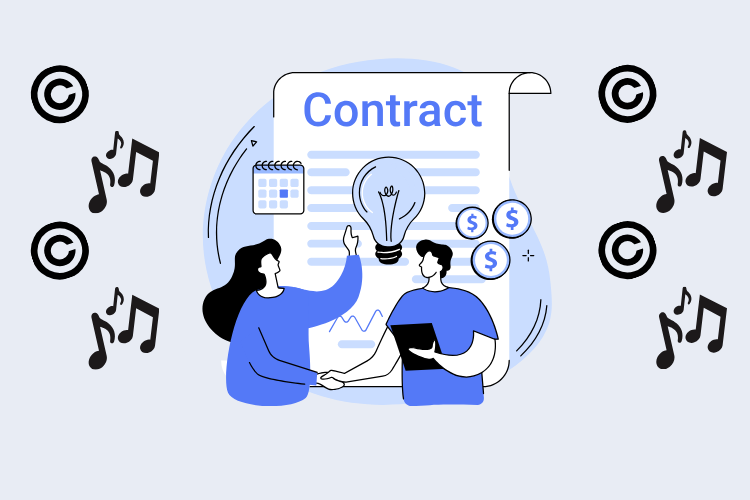In Part I of our Understanding Copyright in Music series, we explored the different types of works and copyright rights in music. In Part II we’ll discuss different types of music licenses.
There are many kinds of music licenses. What and how you license will depend on the type of work you are licensing—whether it is a musical work or sound recording (or both)—and what kinds of uses you are allowing the licensee to do with your work. Below is a list of several types of music licenses and how they are used:
Public Performance License
A public performance license grants someone permission to play a song in public, whether to a live or online audience. Recall that a performance is considered “public” when the work is performed in a public place, at a place where a substantial number of persons outside a normal circle of friends and family are gathered, or is transmitted to the public. If someone wants to publicly perform a musical composition, they must obtain a public performance license to do so.
The owners of the public performance right in the underlying musical work typically authorize a Performance Rights Organization (or PRO), such as ASCAP, BMI, SESAC, and GMR, to license these rights. As discussed in Part I, owners of sound recordings only have a public performance right when the performance occurs by means of a digital audio transmission. That right is administered by Sound Exchange. But no license would be required when the transmission of the sound recording is by a terrestrial or other non-digital transmission, for example over broadcast radio.
Mechanical License
A mechanical license grants someone permission to reproduce and distribute a copy of a musical work and is required when someone wants to create and distribute copies of a song—whether in physical or digital form or whether it’s a recording of an original song or a cover version. This is because in all these examples, the musical work is being copied or a copy of it is being distributed. For example, if someone wants to use the musical work in a CD, a vinyl record, or a digital download of a song, they’ll need a mechanical license.
The Mechanical Licensing Collection (MLC) administers blanket mechanical licenses for musical compositions to eligible digital streaming and download services. A “blanket license” is a single license that allows the licensee to use any musical work in a catalogue. In the case of The MLC, the blanket license covers all musical works in the United States. The alternative to a blanket license is song-by-song licensing, which requires a licensee to obtain a license for every song they want to use on an individual basis. The blanket license covers interactive streams, limited downloads, and permanent downloads. The MLC does not administer public performance licenses for musical compositions (including for digital radio, or “non-interactive” streaming), and does not administer any rights for sound recordings.
Other organizations also administer mechanical licenses for other uses. For example, the Harry Fox Agency issues licenses for creating and distributing cover songs. Mechanical licenses can also often be obtained directly from the music publisher.
Print License
A print license is a license that allows someone to rearrange, print, or display the music notes or lyrics of a musical work in print. This type of license is required to reproduce or display sheet music or lyrics of a song in printed form. The difference between a mechanical license and a print license is that a mechanical license covers audio reproductions, while a print license covers printed reproductions.
Synchronization (“Sync”) License
A synchronization license (“sync” license) is a license that allows someone to use a musical composition along with a video in an audio-visual work. For example, a songwriter or music publisher would grant a sync license to someone who wants to use a song in a video format, such as a movie, TV show, advertisement, or video game. It would not give them the right to use a sound recording of that musical composition. In order to use the sound recording in the audiovisual, the licensee would also need to obtain a master use license from the owner of the sound recording rights.
Master Use License
A master use license is a license that allows someone to use a particular sound recording in, for example, a movie, television show, or advertisement. Master use licenses are usually available from the record label. Many of the licenses listed above are particular to and only apply to the musical work. The master license is different in that it a license that someone gets from the owner of the master recording of the sound recording.
Understanding Licenses is Important to Getting Compensated and to Protect Your Music
Understanding your rights and the various types of music licenses is important since the terms of those licenses will specify what rights you are licensing and how someone is allowed to use your musical work or sound recording. These licenses will also specify how much and when you will be paid for allowing such use (i.e., your royalties) and for how long these payments will continue, as well as many other aspects that govern the relationship between you, the music licensor, and the person or entity who is using your music, the licensee.
Don’t stop your copyright education here! Be on the lookout for Part III of our Understanding Copyright in Music series, and also be sure to check out Copyright Alliance’s FREE Creator Membership for additional educational resources.






Recommended Comments
Join the conversation
You can post now and register later. If you have an account, sign in now to post with your account.